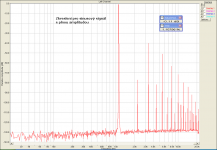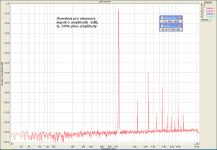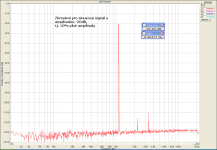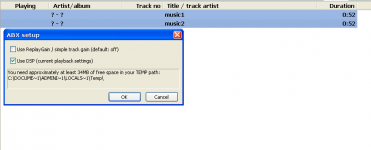Pavel, I totally agree - I'm aiming to have a get together with another fairly well known diyAudio denizen in the next few weeks or so, which means there can some synchronising of ideas, and takes on different audio sound.
A thought I just had - what about creating a series of tracks where very deliberate, software created distortions, of all types, were added to a reference track to create a myriad of tracks with subtle variations - the whole thing done in the digital world, no analogue corruption - available for easy download. People could assess their levels of perception, resolution, transparency of playback setup by using ABX or preferred method, and comparing the reference to the distorted variants - and that would also serve as a common language - "I hear distortion type 7 in this sample of some music, and it's at a level of about 7-2".
A thought I just had - what about creating a series of tracks where very deliberate, software created distortions, of all types, were added to a reference track to create a myriad of tracks with subtle variations - the whole thing done in the digital world, no analogue corruption - available for easy download. People could assess their levels of perception, resolution, transparency of playback setup by using ABX or preferred method, and comparing the reference to the distorted variants - and that would also serve as a common language - "I hear distortion type 7 in this sample of some music, and it's at a level of about 7-2".
Last edited:
A thought I just had - what about creating a series of tracks where very deliberate, software created distortions, of all types, were added to a reference track to create a myriad of tracks with subtle variations - the whole thing done in the digital world, no analogue corruption - available for easy download. People could assess their levels of perception, resolution, transparency of playback setup by using ABX or preferred method, and comparing the reference to the distorted variants - and that would also serve as a common language - "I hear distortion type 7 in this sample of some music, and it's at a level of about 7-2".
Frank, I already went through this path, on our local forum. With digitally added non-linear distortion only, almost no one was able to catch any difference, up to quite high distortion FS level of different patterns. You may see some distortion profiles attached, showing decreasing distortion with level. The distortion was added purely mathematically. I still have the files to test.
Attachments
Thanks for that - do you find the Buffer length makes a difference? I have 3000ms; already have 24 bit output. And nothing in DSP ...
Interesting that you're resampling, I presume that's in real time? I have done many, many experiments with best quality off-line resampling, never real-time, and it's always a plus - I've gone up to ridiculous rates and still keep getting improvements. Big trouble, of course, is that ridiculous amounts of disk space are then required ...
Interesting that you're resampling, I presume that's in real time? I have done many, many experiments with best quality off-line resampling, never real-time, and it's always a plus - I've gone up to ridiculous rates and still keep getting improvements. Big trouble, of course, is that ridiculous amounts of disk space are then required ...
Last edited:
And still on your forum?The distortion was added purely mathematically. I still have the files to test.
I have restored and aligned the files. As said, purely mathematical non-linear distortion.
Here is the new thread with 3 files.
http://www.diyaudio.com/forums/ever...-math-added-harmonic-distortion-new-post.html
Here is the new thread with 3 files.
http://www.diyaudio.com/forums/ever...-math-added-harmonic-distortion-new-post.html
Last edited:
Let's see if I can make some facts "stick" in people's memory banks - the DAC is the motherboard unit, unless I pull the machine apart and probe the traces I don't know what it's seeing.
There are no errors involved, anywhere ... this is about the SQ changing because of the different nature of the internal processing in the PC affecting the conversion and analogue version of the signal - that's what it's about, like it or not ...
The samples of the opamp sound varied from sample to sample - I used some of the characteristics of the X and Y tracks to set the subjective criteria for sorting the samples, but they obviously weren't the right criteria to use - in medical terms, I was looking at the wrong symptoms.
Comparing messy A with messy B is always difficult - what part of the mess do you focus on? The solution I've found is to lift oneself entirely above the 'mess' level, because that's where the real game is ...
Start with the traces connecting directly to input jack and to output jack.
Foobar and its ABX utility access drivers in same way as your other sound apps.
Everything software does, and the way it does it, can have an impact on SQ, especially when the key parts are all in one box. I have spent many years dealing with changes in sound when nothing in the normal electrical sense is altered, when the quality changes over a time period, for no apparent conventional reasons. For me, SQ is a balancing act, getting sufficient elements in alignment, all at the same time - the result of getting that right is that a large jump upwards in subjective quality is experienced, and that's the thing which makes this whole game of audio worthwhile, for me ...
The way that software accesses drivers is just a tiny part of the whole picture ...
The way that software accesses drivers is just a tiny part of the whole picture ...
Step 2 of ABX workaround: Used orig.wav, and copy of that as ABX pair. Started ABX, and then used Audacity to resave one of the temp files as a 24 bit, compared to the other, 32 bit, otherwise identical file. Then kicked off ABX ...
Immediately, obvious difference, in foobar: the 24 bit played much closer to what the sound was in Nero, better treble, very distinct change in tone switching A->B and B->A mid-track. Confirmed that I was dealing with the right file by renaming the adjusted temp, which I guessed corresponded to B - B then wouldn't play.
So, should have a better chance now - simply redo the ABX temp files, to 24 bit tracks, before trying a run - will see how that works out ...
Immediately, obvious difference, in foobar: the 24 bit played much closer to what the sound was in Nero, better treble, very distinct change in tone switching A->B and B->A mid-track. Confirmed that I was dealing with the right file by renaming the adjusted temp, which I guessed corresponded to B - B then wouldn't play.
So, should have a better chance now - simply redo the ABX temp files, to 24 bit tracks, before trying a run - will see how that works out ...
Frank,
In Foobar I opened original.wav and cap2.wav, initiated ABX.
In Cool Edit I opened both files, and the ABX temp files. Then I performed file difference. Properly paired up difference produced perfect zero for all samples of each correct pairing.
Next I closed cap2.wav, opened at file with 32bit floating point format generated in Cool Edit, initiated ABX, went into Cool Edit opened 32bit floating point files of original and ABX temp file, performed file difference, and once again results are perfect zero.
Foobar ABX is blameless in terms of file handling.
In Foobar I opened original.wav and cap2.wav, initiated ABX.
In Cool Edit I opened both files, and the ABX temp files. Then I performed file difference. Properly paired up difference produced perfect zero for all samples of each correct pairing.
Next I closed cap2.wav, opened at file with 32bit floating point format generated in Cool Edit, initiated ABX, went into Cool Edit opened 32bit floating point files of original and ABX temp file, performed file difference, and once again results are perfect zero.
Foobar ABX is blameless in terms of file handling.
That's exactly what I would have suspected, even though I didn't check for null differences. So, yes, the files are identical in the sense of the audio data they contain, but they are different files. As a trivial fact, the 32 bit file is larger.In Cool Edit I opened both files, and the ABX temp files. Then I performed file difference. Properly paired up difference produced perfect zero for all samples of each correct pairing.
Foobar ABX is blameless as regards the integrity of the digital audio data, but something on the path from the digital representation to the completed analogue reconstruction then varies in behaviour. Again, at a trivial level, I've determined, with another media player, Nero in fact, that the same audio data sounds much worse if fed to the media player as a 32 bit file, vs. a 24 bit file, on my machine.
Why this should be so I can't say - the processing pattern has altered by using a different file format, and the analogue output is affected ...
Last edited:
Everytime foobarABX starts it ask you whether it should use resampler pphs etc. The reason why I speak about settings.
This is the dialogue window:
Attachments
Naughty, naughty foobar - this is really getting interesting: it appears as if when using foobar normally then the resampling is being done realtime; but in ABX it's done offline, while creating the temp files. Which means that the replay can be done in high resolution mode, of files which are in true hi-res format - which I've found always improves the replay quality.
Not only that, but the PPHS resampling can be pushed past 96000, it can also do 192000, 384000, and possibly others - that's the format of the temp media files. On my machine foobar will play the 192000 A and B, but rejects 384000.
So, if one is doing ABX of files in 192000, is that "cheating" or not ...?
Not only that, but the PPHS resampling can be pushed past 96000, it can also do 192000, 384000, and possibly others - that's the format of the temp media files. On my machine foobar will play the 192000 A and B, but rejects 384000.
So, if one is doing ABX of files in 192000, is that "cheating" or not ...?
Frank, I am not able to reply your specific questions. The way I check it - I use test files, 1k and possibly 13k+14k, 16 bit and 24 bit, play it through player (here foobar and foobar ABX), record with 24 bit A/D and check the spectrum. Any wrong setting may be revealed this way much easier than by listening only. The "compromised" playback results in added digital FFT artifacts (false lines), especially close to Fs/2. This checks not only foobar, but especially your hardware and it will not let you be cheated by specific hardware and its flaws. Use the settings that work best for you, I have no problems with upsampling to 192/24, as such process is unable to create more resolution than existed in the original file. It can only make your sound reproduction smoother, with a specific hardware. We are discussing in too general level and rational discussion is thus difficult.
- Status
- This old topic is closed. If you want to reopen this topic, contact a moderator using the "Report Post" button.
- Home
- General Interest
- Everything Else
- Listening Test Part 2. Active Circuitry.



